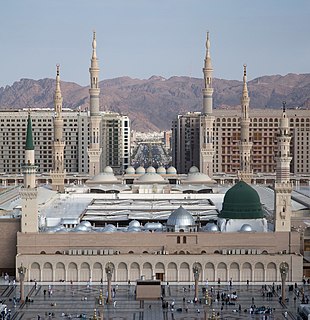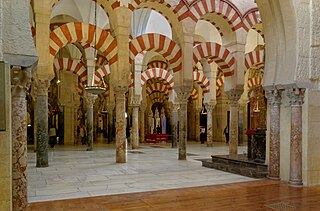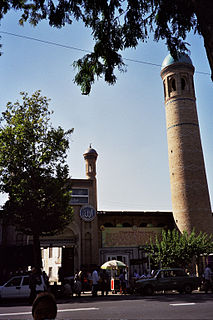
Al-Aqsa Mosque, located in the Old City of Jerusalem, is the third holiest site in Islam. The mosque was built on top of the Temple Mount, known as Haram esh-Sharif in Islam. Muslims believe that Muhammad was transported from the Sacred Mosque in Mecca to al-Aqsa during the Night Journey. Islamic tradition holds that Muhammad led prayers towards this site until the 17th month after his migration from Mecca to Medina, when Allāh directed him to turn towards the Kaaba in Mecca.

The Babri Masjid was a mosque in Ayodhya, India. Located in Faizabad district, it was one of the largest mosques in the Uttar Pradesh state. Before the 1940s, the masjid was officially known as Masjid-i-Janmasthan. According to the mosque's inscriptions, it was built in 1528–29 by Mir Baqi, on orders of the Mughal emperor Babur.

Minaret, from Arabic: منارة manarah, also known as Goldaste, is a type of tower typically found built into or adjacent to mosques. Minarets serve multiple purposes. While they provide a visual focal point, they are generally used for the Muslim call to prayer (Adhan). The basic form of a minaret includes a base, shaft, a cap and head. They are generally a tall spire with a conical or onion-shaped crown. They can either be free-standing or taller than the associated support structure. The architecture, function, and role of the minaret vary by region and time period.

Islamic architecture is the range of architectural styles of buildings associated with Islam. It encompasses both secular and religious styles from the early history of Islam to the present day. Early Islamic architecture was influenced by Roman, Byzantine, Persian, Mesopotamian and all other lands which the Muslims conquered in the 7th and 8th centuries. Further east, it was also influenced by Chinese and Indian architecture as Islam spread to Southeast Asia. Later it developed distinct characteristics in the form of buildings, and the decoration of surfaces with Islamic calligraphy and geometric and interlace patterned ornament. The principal Islamic architectural types for large or public buildings are: the Mosque, the Tomb, the Palace and the Fort. From these four types, the vocabulary of Islamic architecture is derived and used for other buildings such as public baths, fountains and domestic architecture.

The Sultan Ahmed Mosque is a historic mosque located in Istanbul, Turkey. A popular tourist site, the Sultan Ahmed Mosque continues to function as a mosque today; men still kneel in prayer on the mosque's lush red carpet after the call to prayer. The Blue Mosque, as it is popularly known, was constructed between 1609 and 1616 during the rule of Ahmed I. Its Külliye contains Ahmed's tomb, a madrasah and a hospice. Hand-painted blue tiles adorn the mosque’s interior walls, and at night the mosque is bathed in blue as lights frame the mosque’s five main domes, six minarets and eight secondary domes. It sits next to the Hagia Sophia, another popular tourist site.

Mihrab is a semicircular niche in the wall of a mosque that indicates the qibla; that is, the direction of the Kaaba in Mecca and hence the direction that Muslims should face when praying. The wall in which a mihrab appears is thus the "qibla wall".

Al-Masjid an-Nabawī is a mosque established and originally built by the Islamic Prophet Muhammad, situated in the city of Medina in the Hejaz region of Saudi Arabia. It was the third mosque built in the history of Islam, and is now one of the largest mosques in the world. It is the second-holiest site in Islam, after the Great Mosque in Mecca. It is always open, regardless of date or time.

The Masjid-i Jahān-Numā, commonly known as the Jama Masjid of Delhi, is one of the largest mosques in India.

Mughal Architecture is the type of Indo-Islamic architecture developed by the Mughals in the 16th, 17th and 18th centuries throughout the ever-changing extent of their empire in the Indian subcontinent. It developed the styles of earlier Muslim dynasties in India as an amalgam of Islamic, Persian, Turkish and Indian architecture. Mughal buildings have a uniform pattern of structure and character, including large bulbous domes, slender minarets at the corners, massive halls, large vaulted gateways, and delicate ornamentation. Examples of the style can be found in modern-day India, Afghanistan, Bangladesh, and Pakistan.
The El Tawheed Mosque is a Sunni mosque in Amsterdam, Netherlands.

The Grand Mosque seizure occurred during November and December 1979 when armed civilians calling for the overthrow of the House of Saud took over Masjid al-Haram in Mecca, Saudi Arabia. The insurgents declared that the Mahdi had arrived in the form of one of their leaders – Mohammed Abdullah al-Qahtani – and called on Muslims to obey him. For nearly two weeks Saudi Special Forces, assisted by Pakistani and French commandos, fought battles to reclaim the compound.
A jama masjid, also known as a congregational mosque or Friday mosque, is a type of mosque which is the main mosque of a certain area that hosts the special Friday noon prayers known as jumu'ah. They also host the Eid prayers in situations when there is no musalla or eidgah available or nearby to host the prayers.

Moorish architecture is the articulated Islamic architecture of North Africa and parts of Spain and Portugal, where the Andalusians (Moors) were dominant between 711 and 1492. The best surviving examples in Iberia are La Mezquita in Córdoba and the Alhambra palace in Granada, as well as the Giralda in Seville (1184). Other notable examples in Iberia include the ruined palace city of Medina Azahara (936–1010), the church San Cristo de la Luz in Toledo, the Aljafería in Saragossa and baths at for example Ronda and Alhama de Granada.

The following outline is provided as an overview of and topical guide to the Ottoman Empire:

The Badshahi Mosque is a Mughal era masjid in Lahore, capital of the Pakistani province of Punjab, Pakistan. The mosque is located west of Lahore Fort along the outskirts of the Walled City of Lahore, and is widely considered to be one of Lahore's most iconic landmarks.

The Great Mosque of Mecca is a mosque that surrounds the Kaaba in the city of Mecca, Saudi Arabia. It is a site of pilgrimage for the Hajj, which every Muslim must do at least once in their lives if able, the rites of which includes circumambulating the Kaaba within the mosque. It is also the main phase for the ‘Umrah, the lesser pilgrimage that can be undertaken any time of the year. The Great Mosque includes other important significant sites, including the Black Stone, the Zamzam Well, Maqam Ibrahim, and the hills Safa and Marwa. It is open, regardless of date or time.

Evliya Kasim Pasha Mosque is a 15th-century Ottoman mosque in Edirne, northwestern Turkey. It is named after Kasim Pasha.

The Christchurch mosque shootings were two consecutive terrorist attacks at mosques in Christchurch, New Zealand, during Friday Prayer on 15 March 2019. The attacks began at the Al Noor Mosque in the suburb of Riccarton at 1:40 p.m. and continued at the Linwood Islamic Centre at about 1:55 p.m. The gunman livestreamed the first attack on Facebook Live.






















